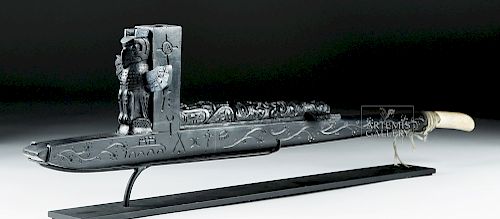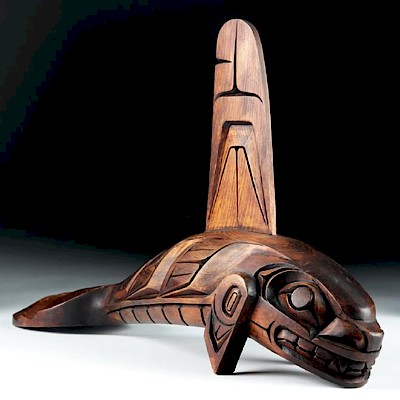19th C. Pacific Northwest Haida Argillite Peace Pipe
Lot 8
About Seller
Artemis Fine Arts
686 S Taylor Ave, Ste 106
Louisville, CO 80027
United States
Selling antiquities, ancient and ethnographic art online since 1993, Artemis Gallery specializes in Classical Antiquities (Egyptian, Greek, Roman, Near Eastern), Asian, Pre-Columbian, African / Tribal / Oceanographic art. Our extensive inventory includes pottery, stone, metal, wood, glass and textil...Read more
Estimate:
$9,500 - $14,500
Absentee vs Live bid
Two ways to bid:
- Leave a max absentee bid and the platform will bid on your behalf up to your maximum bid during the live auction.
- Bid live during the auction and your bids will be submitted real-time to the auctioneer.
Bid Increments
| Price | Bid Increment |
|---|---|
| $0 | $25 |
| $300 | $50 |
| $1,000 | $100 |
| $2,000 | $250 |
| $5,000 | $500 |
| $10,000 | $1,000 |
| $20,000 | $2,500 |
| $50,000 | $5,000 |
| $100,000 | $10,000 |
| $200,000 | $20,000 |
About Auction
By Artemis Fine Arts
May 24, 2018
Set Reminder
2018-05-24 10:00:00
2018-05-24 10:00:00
America/New_York
Bidsquare
Bidsquare : Northwest Coast, Tribal, & Pre-Columbian Art
https://www.bidsquare.com/auctions/artemis-gallery/northwest-coast-tribal-pre-columbian-art-3238
Featuring Pacific Northwest Coast Native American Art from respected collector / dealer, Joseph Alphabet. Artemis Fine Arts info@artemisfinearts.com
Featuring Pacific Northwest Coast Native American Art from respected collector / dealer, Joseph Alphabet. Artemis Fine Arts info@artemisfinearts.com
- Lot Description
Native American, Pacific Northwest coast, Haida, found in Skagway, Alaska according to collection label, ca. 19th century CE. A particularly fine example of an argillite peace pipe extensively decorated with totemic creatures, a proud Thunderbird with outspread wings before the vertical chamber, and a totem pole vertical profusion of animals stacked atop a standing human shamanic figure including (from top to bottom) a Thunderbird, a bear, a frog with a long tongue lapping upward, and a raven. Note the impressive artistry of this piece - how one figure practically flows into the next due to the expert carving technique. As if the two totemic scenes were not enough, the artisan also embellished the flat surfaces with incised floral vines and indigenous clan symbols. The mouthpiece is made of bone (marine mammal or deer) and grey sinew ties are wrapped around the juncture between it and the stem of the pipe. Truly a museum quality example. Size: 25.625" L x 5.75" H (65.1 cm x 14.6 cm); 7.75" H (19.7 cm) on included custom stand.
Argillite (in Haida, kwawhlahl) is a black, dense, carbonaceous shale which is only found in one site - Tllgaduu (Slatechuck) Creek near Hlragilda 'Ilnagaay) on Graham Island, Haida Gwaii (Queen Charlotte Islands). In the 19th century, the Haida people began to carve this material as a good to trade with visiting Europeans and Americans. This trade was significant due to the decline of their traditional fishing-centered economy. Items like this peace pipe served as a way to demonstrate their artistic merit and introduce their indigenous iconography to the outside world. Artisans who carved argillite prior to 1890 generally preferred to leave evidence of their tool marks on the surface of their carved works; however, after 1890, artisans meticulously polished their carvings with fine abrasives, resulting in a very smooth surface which was oftentimes further polished with mixtures of Vaseline, shoe polish, graphite, and other materials in order to enhance the lustre of the argillite. This peace pipe displays many scratches from tool marks of the artisan, indicating that the piece was most likely created prior to 1890. (Macnair, Peter L. and Alan L. Hoover. 2002. "The Magic Leaves: A History of Haida Argillite Carving." Victoria, British Columbia: Royal British Columbia Museum, p. 12.)
For more information on Argillite carvings, read "Plymouth City Museum and Art Gallery Canadian Northwest Coast Collection Research Report: Argillite, horn spoons and Model Totem Poles," by Emma Knight (7/27/2012) - https://plymhearts.org/wp-content/uploads/2016/03/PCMAG-Northwest-Coast-Collection-Research-Report-Plymouth1-public_V02.pdf
Provenance: private Newport Beach, California, USA collection
All items legal to buy/sell under U.S. Statute covering cultural patrimony Code 2600, CHAPTER 14, and are guaranteed to be as described or your money back.
A Certificate of Authenticity will accompany all winning bids.
We ship worldwide and handle all shipping in-house for your convenience.
#133431Surface shows scratches from tool marks; this suggests that the piece was created prior to 1890 (see extended description). Minor losses to ends of sinew ties. Bone mouthpiece shows expected dessication.Condition
- Shipping Info
-
All shipping is handled in-house for your convenience. Your invoice from Artemis Gallery will include shipping calculation instructions. If in doubt, please inquire BEFORE bidding for estimated shipping costs for individual items.
-
- Buyer's Premium



 EUR
EUR CAD
CAD AUD
AUD GBP
GBP MXN
MXN HKD
HKD CNY
CNY MYR
MYR SEK
SEK SGD
SGD CHF
CHF THB
THB















